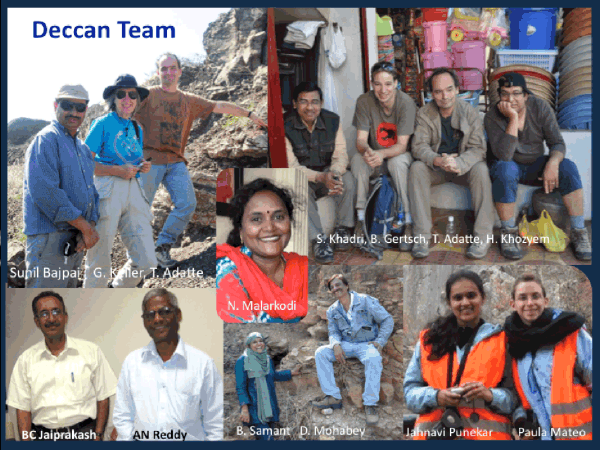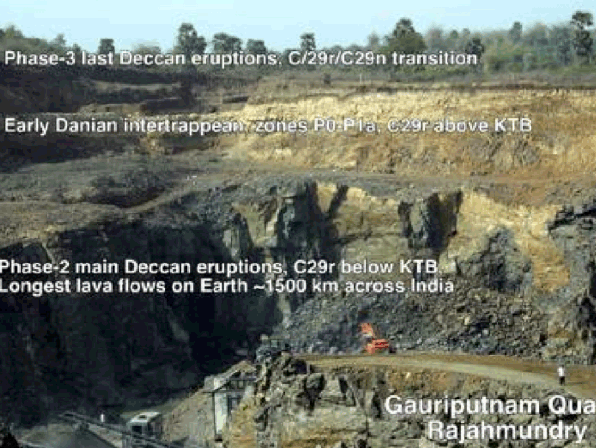In 1980, when the impact hypothesis was proposed by Alvarez et al. (1980), McLean (1978) had already advocated Deccan volcanism as the most likely cause for the KTB mass extinction. This set the paleontologist Dewey McLean on a direct collision course with the father - son (physicist-geologist) team of Luis and Walter Alvarez. Most dinosaur experts at the time were highly skeptical and often critical of the impact hypothesis, because they could not reconcile the gradual decline evident in the fossil record with a sudden death by impact.
In 2006 our team began an intensive collaborative effort with Indian scientists to search for the KT boundary in sediments between Deccan lava flows (intertrappeans) as well as above and below. We first focused on Deccan Traps in the Krishna-Godavari Basin near Rajahmundry where basalt is quarried exposing one intertrappean unit between lower (phase-2) and upper (phase-3) Deccan traps. At the end of the Cretaceous, Rajahmundry was in a shallow estuarine environment, which presented a chance that marine microfossils could be present.
The first direct link between Deccan volcanism and the KTB mass extinction was established in four Rajahmundry quarries (Keller et al., 2008). The longest lava flows of the Phase-2 mega-eruptions are best known from these basalt quarries. Intertrappean sediments above Phase-2 basalts span up to 8 m of sediments deposited in a shallow near-shore marine environment. These intertrappean sediments contain earliest Danian planktic foraminiferal assemblages of zone P1a, which mark the evolution in the aftermath of the mass extinction. Deccan Phase-3 volcanic layers overlie the intertrappeans and mark the last Deccan eruptions.
The Krishna-Godavari Basin expands from Rajahmundry seaward to the Bay of Bengal. In this basin the lava flows are buried under 2000 m to 4000 m of sediments marking rapid subsidence. Drilling by the Oil and Natural Gas Corporation of India has recovered numerous cores from this area and twelve wells have been studied to evaluate the KTB and its relationship to Deccan volcanism. The wells were sampled at the Rajahmundry core library.
AGE: Global Biozonation Scheme
The high-resolution planktic foraminiferal biostratigraphic zonal scheme developed by Keller et al. (1995, 2002) for the Danian and by Li and Keller (1998a,b) for the Maastrichtian is applied in the K-G Basin wells. The KTB can be globally identified based on a number of criteria: the mass extinction of planktic foraminifera, the evolution of the first Danian species within a few centimeters above the extinction horizon, a clay layer with a millimeter thin oxidized red layer at the base, an iridium anomaly in the red layer, and a 2 to 3 permil d13C shift across the clay layer (Keller et al., l995; Cowie et al., 1989; Remane et al., 1999).
Deccan intertrappean sediments in central India are generally terrestrial deposits of Maastrichtian age. However, we discovered the KTB transition in a marine incursion within intertrappean sediments at Jhilmili, Chhindwara District, Madhya Pradesh. Integrative biostratigraphic, sedimentologic, mineralogic and chemostratigraphic analyses reveal the basal Danian in the intertrappean sediments between lower and upper trap basalts that regionally correspond to C29r and the C29R/C29N transition, respectively. From Keller et al., 2009a.
In Meghalaya, one of the most complete KTB sequences worldwide was recovered along the Um Sohryngkew River, which at KTB time was located about 800-1000 km from the main Deccan volcanic province. This section provides critically important information on the effects of Deccan volcanism at 1000 km distance from the volcanic province. The information gained from this locality shows that the Deccan catastrophe was severe and caused near total devastation long before the final phase at the KTB mass extinction.
Most Recent Contributions
Invited research article








